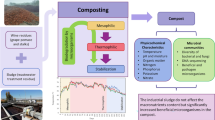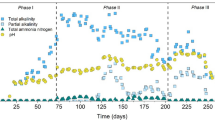Abstract
Black soldier fly larvae have been proven to reduce greenhouse gas emissions in the treatment of organic waste. However, the microbial mechanisms involved have not been fully understood. The current study mainly examined the dynamic changes of carbon and nitrogen, greenhouse gas emissions, the succession of microbial community structure, and changes in functional gene abundance in organic waste under larvae treatment and non-aeration composting. Thirty percent carbon and 55% nitrogen in the organic waste supplied were stored in larvae biomass. Compared to the non-aeration composting, the larvae bioreactor reduced the proportion of carbon and nitrogen converted into greenhouse gases (CO2, CH4, and N2O decreased by 62%, 87%, and 95%, respectively). 16S rRNA sequencing analysis indicated that the larvae bioreactor increased the relative abundance of Methanophaga, Marinobacter, and Campylobacter during the bioprocess, enhancing the consumption of CH4 and N2O. The metagenomic data showed that the intervention of larvae reduced the ratio of (nirK + nirS + nor)/nosZ in the residues, thereby reducing the emission of N2O. Larvae also increased the functional gene abundance of nirA, nirB, nirD, and nrfA in the residues, making nitrite more inclined to be reduced to ammonia instead of N2O. The larvae bioreactor mitigated greenhouse gas emissions by redistributing carbon and nitrogen and remodeling microbiomes during waste bioconversion, giving related enterprises a relative advantage in carbon trading.






Similar content being viewed by others
Data Availability
Data will be made available on request.
References
Akdeniz N (2019) A systematic review of biochar use in animal waste composting. Waste Manage 88:291–300. https://doi.org/10.1016/j.wasman.2019.03.054
Bay SK, Dong X, Bradley JA, Leung PM, Grinter R, Jirapanjawat T, Arndt SK, Cook PLM, Larowe DE, Nauer PA, Chiri E, Greening C (2021) Trace gas oxidizers are widespread and active members of soil microbial communities. Nat Microbiol 6(2):246–256. https://doi.org/10.1038/s41564-020-00811-w
Chen X, Zhang S, Liu J, Wang J, **n Y, Sun S, **a X (2023) Tracing microbial production and consumption sources of N2O in rivers on the qinghai-tibet plateau via isotopocule and functional microbe analyses. Environ Sci Technol 57(18):7196–7205. https://doi.org/10.1021/acs.est.3c00950
Chu Y, Wang J, Jiang L, Tian G, He R (2022) Intermittent aeration reducing N2O emissions from bioreactor landfills with gas-water joint regulation. Waste Manage 139:309–320. https://doi.org/10.1016/j.wasman.2021.12.041
Coskun D, Britto DT, Shi W, Kronzucker HJ (2017) Nitrogen transformations in modern agriculture and the role of biological nitrification inhibition. Nat Plants 3(6):17074. https://doi.org/10.1038/nplants.2017.74
Deng Y, **ang F, Tao X, Jiang C, Zhang T, Zhang Z (2022) A full-scale black soldier fly larvae (Hermetia illucens) bioconversion system for domestic biodegradable wastes to resource. Waste Manage Res 41(1):143–154. https://doi.org/10.1177/0734242X221103936
Dvorsky J, Bednarz J, Blajer-Golebiewska A (2023) The impact of corporate reputation and social media engagement on the sustainability of SMEs: perceptions of top managers and the owners. Equilibrium 18(3):779–811. https://doi.org/10.24136/eq.2023.025
Ge J, Huang G, Li J, Sun X, Han L (2018) Multivariate and multiscale approaches for interpreting the mechanisms of nitrous oxide emission during pig manure-wheat straw aerobic composting. Environ Sci Technol 52(15):8408–8418. https://doi.org/10.1021/acs.est.8b02958
Gold M, Tomberlin JK, Diener S, Zurbrugg C, Mathys A (2018) Decomposition of biowaste macronutrients, microbes, and chemicals in black soldier fly larval treatment: a review. Waste Manage 82:302–318. https://doi.org/10.1016/j.wasman.2018.10.022
Graf DRH, Jones CM, Hallin S (2014) Intergenomic comparisons highlight modularity of the denitrification pathway and underpin the importance of community structure for N2O emissions. PLoS ONE 9(12):e114118. https://doi.org/10.1371/journal.pone.0114118
Guo H, Gu J, Wang X, Yu J, Nasir M, Zhang K, Sun W (2020) Microbial driven reduction of N2O and NH3 emissions during composting: effects of bamboo charcoal and bamboo vinegar. J Hazard Mater 390:121292. https://doi.org/10.1016/j.jhazmat.2019.121292
He X, Yin H, Fang C, **ong J, Han L, Yang Z, Huang G (2021) Metagenomic and q-PCR analysis reveals the effect of powder bamboo biochar on nitrous oxide and ammonia emissions during aerobic composting. Bioresour Technol 323:124567. https://doi.org/10.1016/j.biortech.2020.124567
Hénault-Ethier L, Quinche M, Reid B, Hotte N, Fortin A, Normandin É, de La Rochelle RG, Rasooli Zadeh A, Deschamps M, Vandenberg G (2024) Opportunities and challenges in upcycling agri-food byproducts to generate insect manure (frass): a literature review. Waste Manage 176:169–191. https://doi.org/10.1016/j.wasman.2023.12.033
Huang W, Ngo H, Lin C, Vu C, Kaewlaoyoong A, Boonsong T, Tran H, Bui X, Vo T, Chen J (2019) Aerobic co-composting degradation of highly PCDD/F-contaminated field soil. A study of bacterial community. Sci Total Environ 660:595–602. https://doi.org/10.1016/j.scitotenv.2018.12.312
Jiang C, ** W, Tao X, Zhang Q, Zhu J, Feng S, Xu X, Li H, Wang Z, Zhang Z (2019) Black soldier fly larvae (Hermetia illucens) strengthen the metabolic function of food waste biodegradation by gut microbiome. Microb Biotechnol 12(3):528–543. https://doi.org/10.1111/1751-7915.13393
Kliestik T, Nica E, Durana P, Popescu GH (2023) Artificial intelligence-based predictive maintenance, time-sensitive networking, and big data-driven algorithmic decision-making in the economics of Industrial Internet of Things. Oecon Copernic 14(4):1097–1138. https://doi.org/10.24136/oc.2023.033
Li M, Li S, Meng Q, Chen S, Wang J, Guo X, Ding F, Shi L (2023) Feedstock optimization with rice husk chicken manure and mature compost during chicken manure composting: quality and gaseous emissions. Bioresour Technol 387:129694. https://doi.org/10.1016/j.biortech.2023.129694
Maroušek J, Strunecký O, Maroušková A (2023) Insect rearing on biowaste represents a competitive advantage for fish farming. Rev Aquac 15(3):965–975. https://doi.org/10.1111/raq.12772
Meng L, Xu C, Wu F, He Hu (2022) Microbial co-occurrence networks driven by low-abundance microbial taxa during composting dominate lignocellulose degradation. Sci Total Environ 845:157197. https://doi.org/10.1016/j.scitotenv.2022.157197
Pang W, Hou D, Chen J, Nowar EE, Li Z, Hu R, Tomberlin JK, Yu Z, Li Q, Wang S (2020) Reducing greenhouse gas emissions and enhancing carbon and nitrogen conversion in food wastes by the black soldier fly. J Environ Manage 260:110066. https://doi.org/10.1016/j.jenvman.2020.110066
Parodi A, De Boer IJM, Gerrits WJJ, Van Loon JJA, Heetkamp MJW, Van Schelt J, Bolhuis JE, Van Zanten HHE (2020) Bioconversion efficiencies, greenhouse gas and ammonia emissions during black soldier fly rearing - a mass balance approach. J Clean Prod 271:122488. https://doi.org/10.1016/j.jclepro.2020.122488
Parodi A, Gerrits WJJ, Van Loon JJA, De Boer IJM, Aarnink AJA, Van Zanten HHE (2021) Black soldier fly reared on pig manure: bioconversion efficiencies, nutrients in the residual material, greenhouse gas and ammonia emissions. Waste Manage 126:674–683. https://doi.org/10.1016/j.wasman.2021.04.001
Ren G, Xu X, Qu J, Zhu L, Wang T (2016) Evaluation of microbial population dynamics in the co-composting of cow manure and rice straw using high throughput sequencing analysis. World J Microbiol Biotechnol 32(6):101. https://doi.org/10.1007/s11274-016-2059-7
Rincon CA, De Guardia A, Couvert A, Soutrel I, Guezel S, Le Serrec C (2019) Odor generation patterns during different operational composting stages of anaerobically digested sewage sludge. Waste Manage 95:661–673. https://doi.org/10.1016/j.wasman.2019.07.006
Sanchez A, Artola A, Font X, Gea T, Barrena R, Gabriel D, Sanchez-Monedero MA, Roig A, Cayuela ML, Mondini C (2015) Greenhouse gas emissions from organic waste composting. Environ Chem Lett 13(3):223–238. https://doi.org/10.1007/s10311-015-0507-5
Singh SK, Pawar L, Thomas AJ, Debbarma R, Biswas P, Ningombam A, Devi AG, Waikhom G, Patel AB, Meena DK, Chakraborty G (2023) The current state of research and potential applications of insects for resource recovery and aquaculture feed. Environ Sci Pollut Res. https://doi.org/10.1007/s11356-023-29068-6
Stein LY (2020) The long-term relationship between microbial metabolism and greenhouse gases. Trends Microbiol 28(6):500–511. https://doi.org/10.1016/j.tim.2020.01.006
Sun B, Bai Z, Li Y, Li R, Song M, Xu S, Zhang H, Zhuang X (2022) Emission mitigation of CH4 and N2O during semi-permeable membrane covered hyperthermophilic aerobic composting of livestock manure. J Clean Prod 379:134850. https://doi.org/10.1016/j.jclepro.2022.134850
Tao X, **ang F, Khan FZA, Yan Y, Ma J, Xu B, Zhang Z (2023) Decomposition and humification process of domestic biodegradable waste by black soldier fly (Hermetia illucens L.) Larvae from the perspective of dissolved organic matter. Chemosphere 317:137861. https://doi.org/10.1016/j.chemosphere.2023.137861
van den Bergh SG, Chardon I, Meima-Franke M, Costa OYA, Korthals GW, de Boer W, Bodelier PLE (2023) The intrinsic methane mitigation potential and associated microbes add product value to compost. Waste Manage 170:17–32. https://doi.org/10.1016/j.wasman.2023.07.027
Wang Q, Awasthi MK, Ren X, Zhao J, Li R, Wang Z, Wang M, Chen H, Zhang Z (2018) Combining biochar, zeolite and wood vinegar for composting of pig manure: the effect on greenhouse gas emission and nitrogen conservation. Waste Manage 74:221–230. https://doi.org/10.1016/j.wasman.2018.01.015
Wang Y, Tang Y, Yuan Z (2022) Improving food waste composting efficiency with mature compost addition. Bioresour Technol 349:126830. https://doi.org/10.1016/j.biortech.2022.126830
Wang F, Zhao Q, Zhang L, Chen J, Wang T, Qiao L, Zhang L, Ding C, Yuan Y, Qi Z, Chen T (2023a) Co-digestion of chicken manure and sewage sludge in black soldier fly larvae bioconversion system: bacterial biodiversity and nutrients quality of residues for biofertilizer application. Environ Sci Pollut Res 30(57):119804–119813. https://doi.org/10.1007/s11356-023-30717-z
Wang Y, Wang J, Wu X, Zhao R, Zhang Z, Zhu J, Azeem M, **ao R, Pan J, Zhang X, Li R (2023b) Synergetic effect and mechanism of elementary sulphur, MgSO4 and KH2PO4 progressive reinforcement on pig manure composting nitrogen retention. Environ Pollut 331:121934. https://doi.org/10.1016/j.envpol.2023.121934
**ang F, Sheng J, Li G, Ma J, Wang X, Jiang C, Zhang Z (2022) Black soldier fly larvae vermicompost alters soil biochemistry and bacterial community composition. Appl Microbiol Biotechnol 106(11):4315–4328. https://doi.org/10.1007/s00253-022-11947-6
**ang F, Zhang Q, Xu X, Zhang Z (2024) Black soldier fly larvae recruit functional microbiota into the intestines and residues to promote lignocellulosic degradation in domestic biodegradable waste. Environ Pollut 340:122676. https://doi.org/10.1016/j.envpol.2023.122676
Xu Z, Li R, Zhang X, Liu J, Xu X, Wang S, Lan T, Zhang K, Gao F, He Q, Pan J, Quan F, Zhang Z (2023) Mechanisms and effects of novel ammonifying microorganisms on nitrogen ammonification in cow manure waste composting. Waste Manage 169:167–178. https://doi.org/10.1016/j.wasman.2023.07.009
Zeng J, Yin H, Shen X, Liu N, Ge J, Han L, Huang G (2018) Effect of aeration interval on oxygen consumption and GHG emission during pig manure composting. Bioresour Technol 250:214–220. https://doi.org/10.1016/j.biortech.2017.11.010
Zhan S, Fang G, Cai M, Kou Z, Xu J, Cao Y, Bai L, Zhang Y, Jiang Y, Luo X, Xu J, Xu X, Zheng L, Yu Z, Yang H, Zhang Z, Wang S, Tomberlin JK, Zhang J, Huang Y (2020) Genomic landscape and genetic manipulation of the black soldier fly Hermetia illucens, a natural waste recycler. Cell Res 30(1):50–60. https://doi.org/10.1038/s41422-019-0252-6
Zhang H, Matsuto T (2010) Mass and element balance in food waste composting facilities. Waste Manage 30(8–9):1477–1485. https://doi.org/10.1016/j.wasman.2010.02.029
Zhang L, Shi T, Xu Z, Bao Z, Li J, Li G, Yuan J (2023) Effect of lime and calcium magnesium phosphate on gaseous emissions, maturity, and bacterial dynamics during food waste composting. Environ Technol Innov 32:103306. https://doi.org/10.1016/j.eti.2023.103306
Funding
This work was supported by the National Natural Science Foundation of China (grant numbers 42377002, 32171466).
Author information
Authors and Affiliations
Contributions
ZhiJian Zhang: conceptualization; methodology; resources; data curation; writing—review and editing; supervision; project administration; funding acquisition. **nHua Xu: conceptualization; methodology; writing—review and editing; supervision. FangMing **ang: software; formal analysis; investigation; data curation; writing—original draft; visualization. LuYing Han: investigation; writing—original draft. ShuoYun Jiang: formal analysis, visualization.
Corresponding author
Ethics declarations
Ethics approval
This work does not carry out research on humans and animals, and does not involve the use of human subjects.
Consent to participate
Not applicable
Consent for publication
Not applicable
Competing interests
The authors declare no competing interests.
Additional information
Responsible Editor: Giovanni Benelli
Publisher's Note
Springer Nature remains neutral with regard to jurisdictional claims in published maps and institutional affiliations.
Supplementary Information
Below is the link to the electronic supplementary material.
Rights and permissions
Springer Nature or its licensor (e.g. a society or other partner) holds exclusive rights to this article under a publishing agreement with the author(s) or other rightsholder(s); author self-archiving of the accepted manuscript version of this article is solely governed by the terms of such publishing agreement and applicable law.
About this article
Cite this article
**ang, F., Han, L., Jiang, S. et al. Black soldier fly larvae mitigate greenhouse gas emissions from domestic biodegradable waste by recycling carbon and nitrogen and reconstructing microbial communities. Environ Sci Pollut Res 31, 33347–33359 (2024). https://doi.org/10.1007/s11356-024-33308-8
Received:
Accepted:
Published:
Issue Date:
DOI: https://doi.org/10.1007/s11356-024-33308-8




